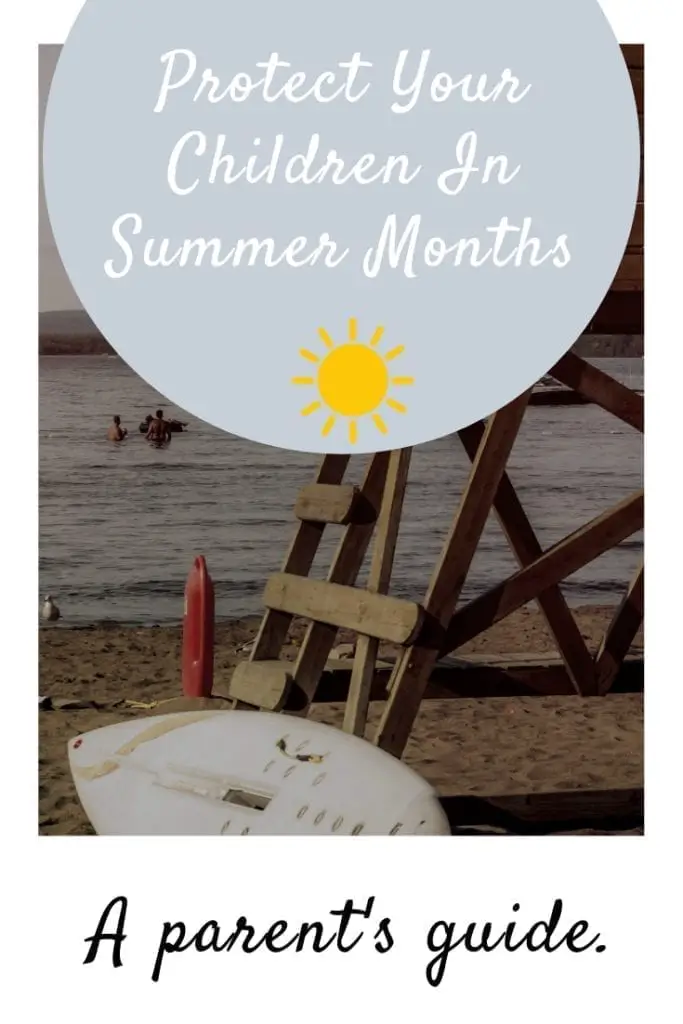Ah, Summer. It’s the best time of the year (for most people). Barbeques, picnics, fun in the sun, vacations, and splashing around in the pool. Children all around are excited to be out of school enjoying the outdoors and playing. But while the hot weather is the perfect climate for so many wonderful activities and things to do, there are a few things you should consider to protect your children in the Summer.
This post contains affiliate links, for which I may be compensated a small amount if you click on them and purchase something.
Table of Contents
1. Keeping Your Kids Cool And Protected Is Important
Children love playing outside and enjoying the sun but remember that exposure to the sun isn’t always a good thing. Keep refreshing items ready at hand for your child. Also, popsicles are a great treat to beat the heat. Be sure to buy popsicles with little to no added sugar. If you want, you can easily make your own popsicles out of natural fruit juices. Your kids will absolutely love it, and they will stay cooled off. And be sure to keep plenty of water available for your thirsty kiddos.
The recommended daily amount of fluids is:
5 glasses (1 litre) for 5 to 8 year olds
7 glasses (1.5 liters) for 9 to 12-year-olds
8 to 10 glasses (2 liters) for 13+ years
Keeping direct sunlight off of your children as much as possible is also helpful. When you dress your child, dress them in lightly colored, breathable clothing. This will help keep them from becoming unnecessarily hot and sweaty. Also, be sure to keep a hat on their head if you can (I know my kid hates hats for the most part). Try buying a hat with some form of chin strap, such as a child’s safari-style hat. Oh, and be sure to protect your child’s eyes with sunglasses
if you can!
Eye Sunburn Is Real
Believe it or not, eye sunburn is a real thing, and kids are most susceptible to it. Symptoms can include:
- A sensation of grit in the eye
- Extreme sensitivity to light
- Tearing
- Redness
- Blurry or haloed vision
- Swollen and twitching eyelids
- Headache
- Small pupils
- In rare cases, temporary vision loss
To avoid photokeratitis (a fancy term for sunburnt eyes) the American Optometric Association recommends wearing shades that:
- Block at least 99 percent of UVA and UVB rays.
- Screen 75 to 90 percent of visible light.
- Have no imperfections that cause distortion.
- Feature gray lenses.
2. Keep A Close Eye When Little Ones Are In Or Near The Pool
Swim time can be an incredibly fun way to spend a hot summer day with your kids. Kids love splashing and giggling while riding around on their favorite pool floaties or going down water slides. It can be a great way to bond with your kids too! Please still keep in mind though that water can be dangerous to young children. Water safety steps must be taken to protect your children in the Summer months when water play is prevalent.
Here are some startling facts about kids and water to consider.
According to the CDC children 1-4 have the highest drowning rate. Most of those drownings happen in their own home swimming pools. Statistically most of those children were unsupervised and were wandering around the water where the incident occurred. Some of the children may have had no intention of going into the water at all but slipped or fell in by accident. All of this is preventable. Be always aware of where your children are playing. It does not take long for a drowning to occur.
IN THE TIME IT TAKES TO…
Cross a room for a towel (10 seconds), a child in a bathtub can be submerged.
Answer the phone (2 minutes), a child can lose consciousness.
Sign for a package at the front door (4-6 minutes), a child submerged in a tub or pool can sustain permanent brain damage.
3. Take Extra Care During Your Firework Shows and Festivities
The Fourth of July can be one of the best holidays to get together with your family. Food, fun, and fireworks! Everyone loves seeing a spectacular light show in the night sky whilst among your closest friends and family. Children and parents alike will be awestruck by the colorful splendor. Just remember that fireworks can be extremely dangerous if not handled properly.
Beware of Sparklers!
One of the potentially most dangerous type of fireworks for a child to be exposed to is the average sparkler. A childhood staple for some. Many parents often fail to see the potential dangers a simple sparkler can yield to a child. Did you know that sparklers can burn at temperatures of 2,000 degrees Fahrenheit or higher? That is hot enough to burn some metals. In fact back in 2016 there was an estimated 900 emergency room visits related to the use of sparklers. 400 of those visits were children ages 0-4 years of age.
Monitor your children closely with any kind of fireworks.
To prevent firework related injuries, monitor your child closely if they are handling sparklers. Keep a bucket of water handy to throw the sparkler in once it is done burning as they can still be extremely hot long after they have gone out. If adults are lighting fireworks at home make sure to keep a safe distance away from them after lighting, keep a garden hose handy in case of a mishap. No one wants their Fourth of July festivities to end with a trip to the hospital.
4. Use Proper Sunblock For Your Kids (And Yourself)
Keeping you and your children safe from overexposure to the sun can be critical. No one likes a sunburn, it can be extremely uncomfortable and painful. I speak from my own terrible childhood experience after a day out at the public pool (ouch). We all know the obvious potential negative impacts the sun can have on our bodies. Skin cancer is the most common form of cancer in the United States.
What the CDC recommends.
The CDC recommends using a broad-spectrum sunscreen with SPF 15+ at least. Personally, I prefer SPF 30+ because of the increased protection it offers. Do your best to avoid spray on sunscreen, it is hard to keep children from breathing in or ingesting some of the product.
Choose Wisely When It Comes To Sunscreen.
Even some of the safest types of sunscreen contain potentially harmful chemicals. Using sunscreen above SPF 50+ is not recommended, as it tends to be used improperly. Higher SPF sunscreens contain a higher concentration of chemicals and do not provide the balance of protection from UVA and UVB rays as lower SPF sunscreens.
5. Playground Safety
Playgrounds are a popular destination for children during the summer, but they can also be a hotspot for accidents and injuries if proper precautions aren’t taken. Before allowing your child to play on a playground, inspect the equipment for any signs of damage or disrepair, such as rusted metal or loose bolts. Ensure the playground surface is soft and shock-absorbent, such as wood chips or rubber mulch, to cushion falls and reduce the risk of injury. Supervise your children closely while they play, and encourage them to use playground equipment safely and responsibly.
6. Protecting Against Insect Bites
Summer brings out the sunshine and pesky bugs like mosquitoes, ticks, and bees. To protect your child from insect bites and potential diseases, use insect repellent containing DEET or picaridin when spending time outdoors, especially in wooded or grassy areas. Dress your child in light-colored clothing that covers their arms and legs, and avoid using scented lotions or perfumes that may attract bugs. Check your child’s skin for ticks after spending time outside, and remove any ticks promptly using tweezers.
7. Take Care With Little Ones In The Car During Hot Months!
This one is hard for me to write about as it is one of the most horrifying things I can imagine as a parent. 761 children have died due to pediatric vehicular heat stroke since 1998. There have already been at least 18 cases documented this year. 54% of the incidences were the result of a caregiver forgetting a child in the car. More than half of the children were ages 2 and under. This is absolutely unbelievable, and I wonder how a human being could FORGET a child in the car.
Statistically, it is possible.
I am unsure how this is possible, but statistically, it is, and it does unfortunately happen. According to the CDC, when temperatures outside range from 80-100, the temperature inside a car parked in direct sunlight can quickly climb to between 130 to 172. Children have died in cars with the temperature as low as 63 degrees.
This video may be hard for some viewers to watch but it is a reenacted version of what could happen when a child is left alone in a hot car. (No one was hurt in real life in this video!) It is simply to bring awareness to the sad epidemic in the United States. I did not create this video.
Products that can help prevent the worst from happening.
If this video has you worried for one reason or another there are some products out there that could provide a bit of peace of mind. I would have to assume that most of these cases involved a parent or caregiver who was rushed, hurried, late, frantic, or forgetful. But, whatever the case may be, there are several products on the market to help you keep track of your children.
Even if you, like myself, feel it’s impossible to forget your own child in a car you know that it only takes a matter of moments for your child to leave your side and end up somewhere they don’t belong. For instance, if you are playing out in the yard with your kid or at the store and turn around for a moment, your child could be feet away from you doing something they shouldn’t.
Stay Vigilant
Protect your children in the Summer months. Be extra vigilant and keep track of them at all times. May your summer be fun-filled and stress-free by being prepared. Our little ones make life worth living, and let us all take a little more time this season to ensure everyone can have a safe and joyous Summer.
– Sincere Mommy
If you liked this post, you may also like my post about getting back into exercise after pregnancy.

